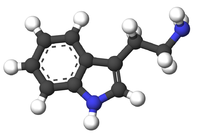Tryptamine
 |
|
 |
|
| Names | |
|---|---|
|
IUPAC name
2-(1H-Indol-3-yl)ethanamine
|
|
| Identifiers | |
|
61-54-1 |
|
| 3D model (Jmol) | Interactive image |
| ChEMBL |
ChEMBL6640 |
| ChemSpider |
1118 |
| ECHA InfoCard | 100.000.464 |
| 125 | |
| PubChem | 1150 |
|
|
|
|
| Properties | |
| C10H12N2 | |
| Molar mass | 160.22 g·mol−1 |
| Appearance | white to orange crystalline powder |
| Melting point | 113-116˚C |
| Boiling point | 137˚C (0.15 mmHg) |
| negligible solubility in water | |
| Hazards | |
| Flash point | 185˚C |
|
Except where otherwise noted, data are given for materials in their standard state (at 25 °C [77 °F], 100 kPa).
|
|
|
|
|
| Infobox references | |
Tryptamine is a monoamine alkaloid. It contains an indole ring structure, and is structurally similar to the amino acid tryptophan, from which the name derives. Tryptamine is found in trace amounts in the brains of mammals and is hypothesized to play a role as a neuromodulator or neurotransmitter.
Tryptamine is the common functional group in a set of compounds termed collectively substituted tryptamines. This set includes many biologically active compounds, including neurotransmitters and psychedelic drugs.
The concentration of tryptamine in rat brains is about 3.5 pmol/g.
Many plants contain small amounts of tryptamine. It is a feedstock for the metabolic pathways which influence plant growth and microbiome. For example, it is found as a possible intermediate in one biosynthetic pathway to the plant hormone indole-3-acetic acid. Higher concentrations can be found in many Acacia species.
Tryptamine acts as a non-selective serotonin receptor agonist and serotonin-norepinephrine-dopamine releasing agent (SNDRA), with a preference for evoking serotonin and dopamine release over norepinephrine release. It is rapidly metabolized by MAO-A and MAO-B, and for this reason, has a very short in vivo half-life.
...
Wikipedia
